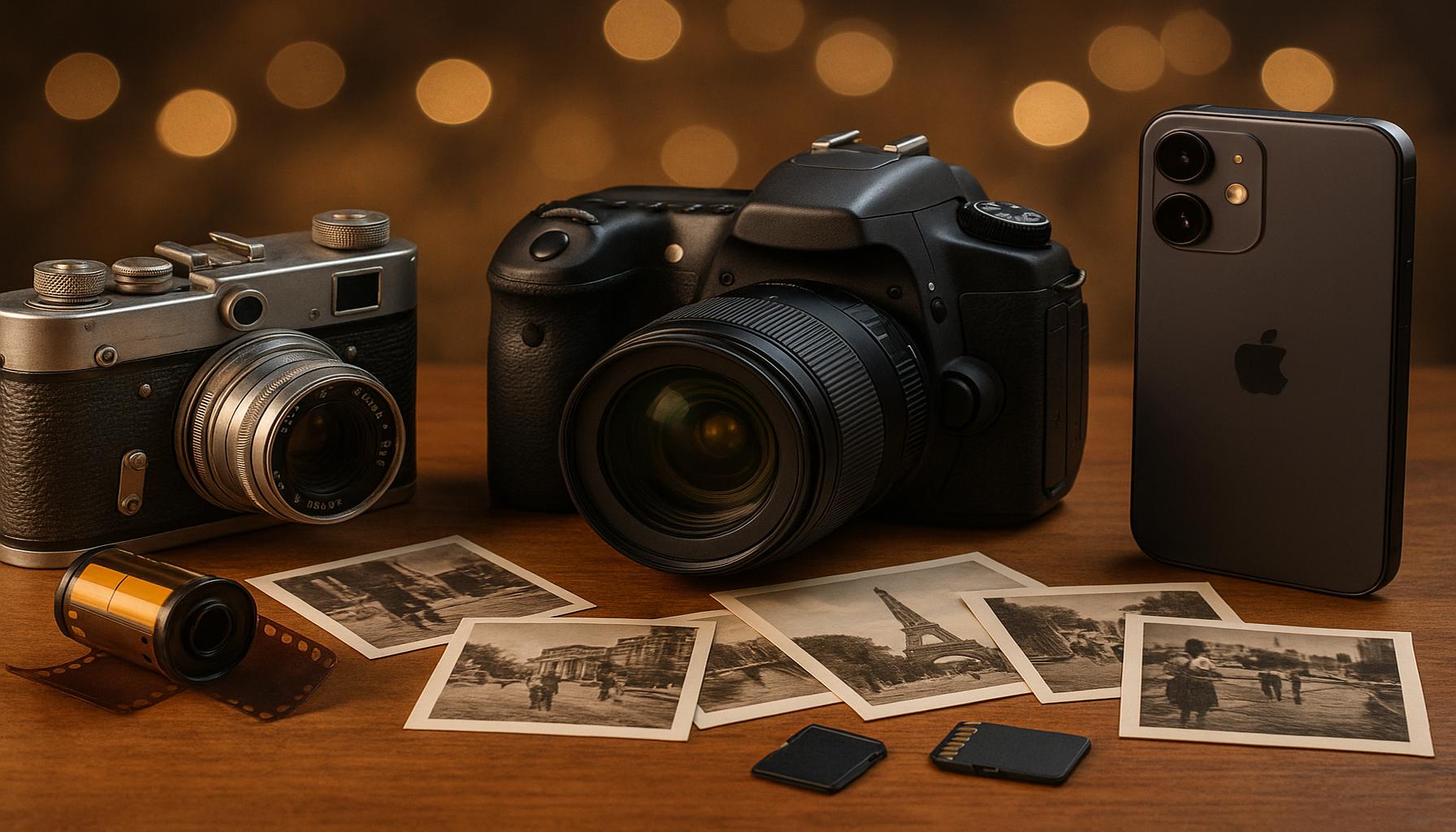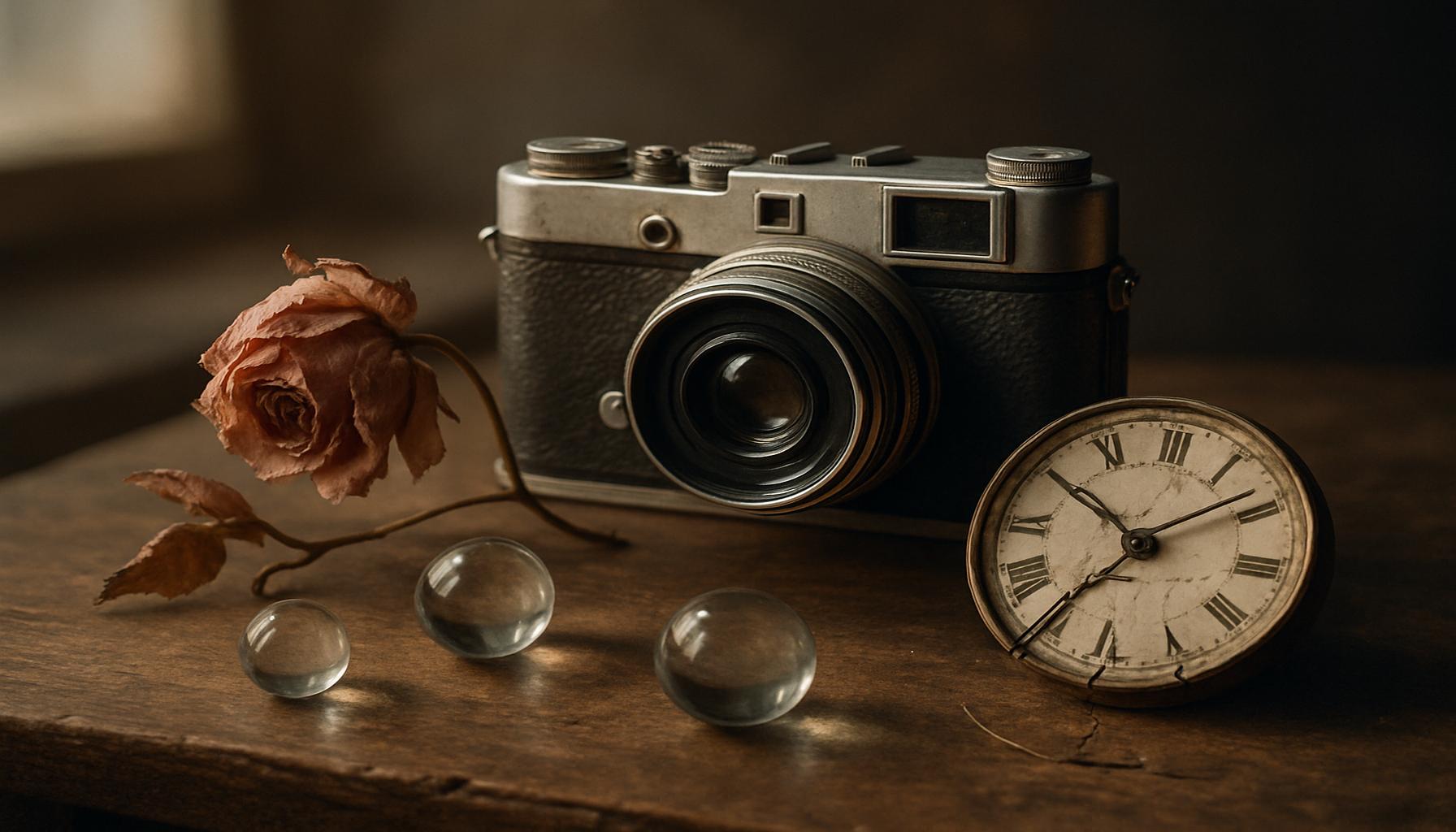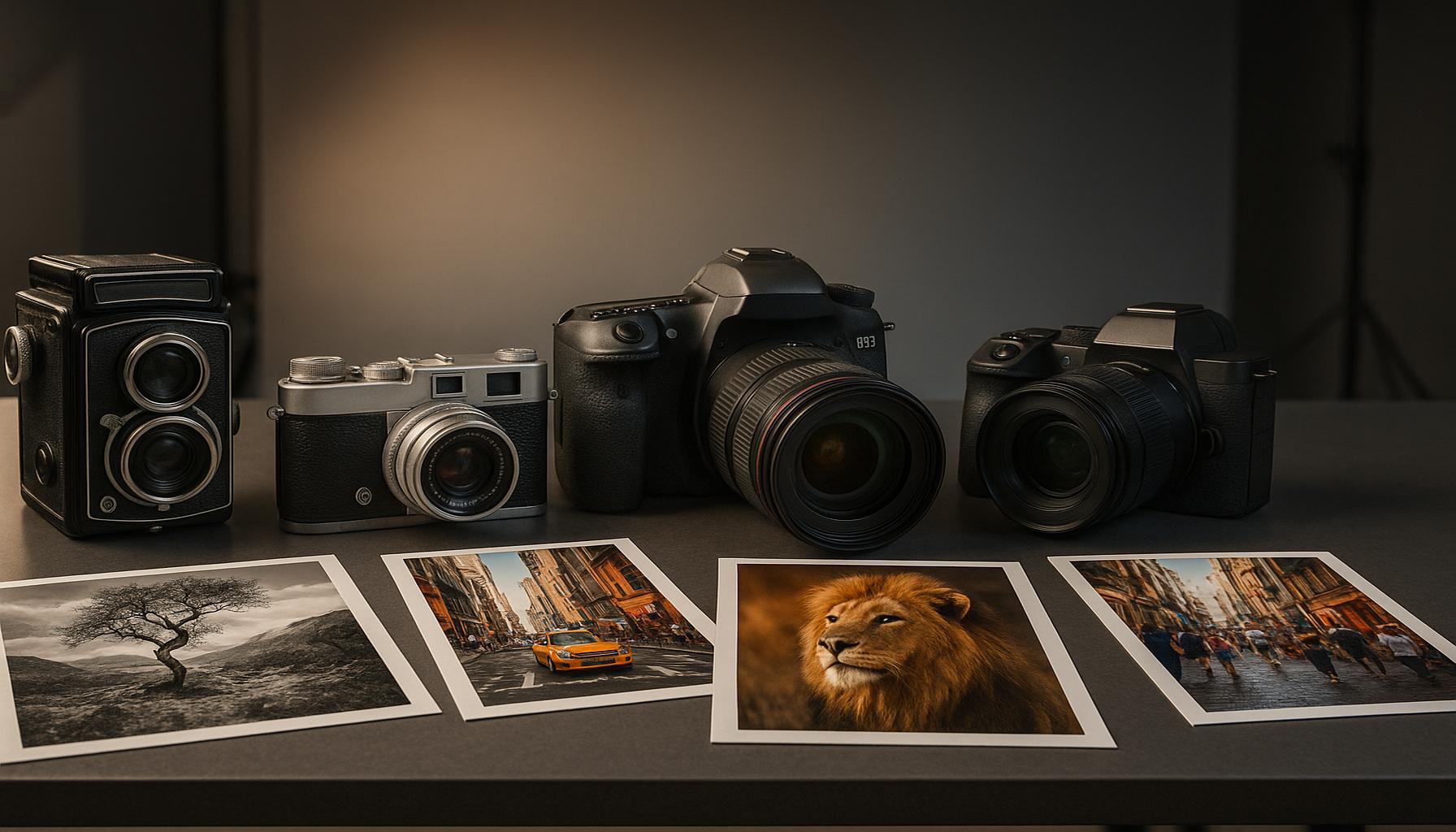The Evolution of Digital Photography: How Technology Transformed the Art of Capturing Moments

The Evolution of Photography: From Film to Digital and Beyond
The journey of photography has continuously evolved, embracing myriad technological advances that have drastically reshaped the way we capture and interact with images. The transition from cumbersome film cameras to sleek digital devices is just one piece of this transformative puzzle. Over the last few decades, photography has morphed from a specialized craft into a ubiquitous form of modern expression, thanks to advancements in technology.
Film to Digital
The transition from film roll cameras to digital sensors revolutionized not just the act of capturing an image, but the entire photographic process. Previously, photographers were confined to a finite number of exposures per film roll, necessitating careful consideration before each click of the shutter. With digital cameras, instant feedback became a game-changer; images could be reviewed and discarded on the spot. This immediacy fostered creativity and experimentation, allowing photographers to explore new techniques without the fear of wasting film.
Smartphone Integration
Perhaps one of the most significant milestones in the photography landscape has been the advent of the smartphone. With smartphones now equipped with high-quality cameras capable of professional-grade photography, the art form has become remarkably accessible to the masses. Platforms like Instagram and Snapchat have further fueled this trend by allowing users to share images instantly with a global audience. According to a report from 2021, approximately 92% of Americans owned a smartphone, highlighting the pervasiveness of smartphone photography. This democratization means that everyone from casual social media users to aspiring photographers have the tools readily available to express their creativity.
Photo Editing Software
The rise of photo editing software has fundamentally altered how images are produced and shared. Programs like Adobe Photoshop and mobile applications such as Snapseed provide powerful tools for enhancing images, enabling users to manipulate color, contrast, and composition with ease. These technologies have led to the widespread practice of digital retouching, where even candid photos can be polished to perfection before being shared with the world. This phenomenon not only affirms the aesthetic values of society but also raises important conversations around authenticity in visual media.
This transformation has significantly changed the techniques and tools employed in photography, but it has also redefined communication and creativity in our visual culture. Every technological leap opens new avenues for exploration, expanding the artistic palette for both amateur and professional photographers. As we continue to examine the innovations within the realm of digital photography, we gain insight into how these developments have shaped not only the art form but also our personal experiences and societal narratives.
In conclusion, the ongoing evolution of photography is a reflection of broader cultural shifts and technological advancements. Each step in this journey invites us to explore deeper and encourages a shared dialogue about the visual stories we tell and the meanings we derive from them.
DIVE DEEPER: Click here to explore the evolution of craftsmanship
Embracing Technology: The Changing Landscape of Photography
As we delve deeper into the evolution of digital photography, it is essential to explore how technology has not only enhanced the mechanics of capturing images but has also transformed the very essence of photography itself. From the days when photographers relied on physical film to a world dominated by digital sensors and advanced algorithms, the art of taking pictures has seen remarkable changes.
High-Resolution Sensors and Image Quality
One of the most significant advancements in digital photography is the development of high-resolution image sensors. In the early 2000s, a standard digital camera would have a resolution of around 5 to 10 megapixels, sufficient for basic prints but far from the quality that professionals desired. Fast forward to today, and we see cameras equipped with sensors boasting up to 100 megapixels or more, capturing astonishing detail and dynamic range.
- Enhanced Low-Light Performance: Modern digital sensors have improved capabilities in low-light conditions, enabling photographers to shoot in settings that would have been previously considered challenging.
- Dynamic Range: The range of brightness that a sensor can capture has expanded, allowing for more balanced exposures in both highlights and shadows.
- Color Accuracy: Advanced sensor technologies facilitate better color reproduction, resulting in more lifelike and vibrant images.
The impact of high-resolution sensors is profound. Professional photographers can now make large-format prints without losing quality, while everyday users can capture memories with remarkable clarity. This shift has not only elevated the standard of photography but has also increased expectations among audiences who consume photographic content.
Emergence of Mirrorless Technology
Another groundbreaking development is the rise of mirrorless cameras. Unlike traditional DSLR cameras that rely on mirrors to reflect light into an optical viewfinder, mirrorless cameras use electronic viewfinders and LCD screens for composing shots. This fundamental change has rendered these cameras lighter, more compact, and significantly quieter. Notably, the continuous autofocus and faster shooting capabilities of mirrorless systems cater to dynamic environments, making them essential tools for event and wildlife photographers.
This evolution has not only changed professional photography but has also trickled down to the amateur level. Many enthusiasts are investing in mirrorless systems for their versatility and performance. As more photographers make the switch, the demand for high-quality mirrorless lenses and accessories continues to grow, changing the market landscape.
The Role of Social Media and Instant Sharing
The advent of social media platforms cannot be understated in the discussion of digital photography’s evolution. Platforms like Instagram, Twitter, and Facebook have created new avenues for sharing images, reshaping how photographers present their work and how audiences engage with visual content. Now, a stunning photograph captured on a smartphone can instantaneously reach millions, enabling a democratization of photography.
This instant sharing has also influenced the types of images that gain popularity. Many users now gravitate towards aesthetics that thrive on social media, often favoring bold colors and unique perspectives that stand out in crowded feeds. As a result, this shift has redefined the concept of “success” in photography, emphasizing engagement and visibility over traditional metrics.
As we explore the intertwining of technology and creativity further, it becomes evident that the journey of digital photography is far from complete. With ongoing advancements and shifts in societal trends, the way we capture moments continues to evolve, inviting both tangible and abstract discussions about our relationship with images and the memories they preserve.
As we delve deeper into the evolution of digital photography, it is essential to recognize the pivotal role that technology has played in shaping this art form. One of the primary transformations has been the shift from film to digital sensors. Early digital cameras utilized image sensors that were rudimentary compared to today’s standards, limiting the quality and usability of photographs. However, advancements in technology have led to the development of high-resolution digital sensors that capture images with remarkable detail and clarity, enabling photographers to realize their creative visions like never before.In addition to improved sensors, the incorporation of machine learning algorithms has revolutionized post-processing capabilities. Modern cameras and smartphones now come equipped with sophisticated software that automatically enhances images, adjusts lighting, and even suggests framing, making photography more accessible to amateurs. These advancements allow photographers to focus more on the creative process rather than being bogged down by technicalities.Moreover, the rise of social media platforms has transformed how images are shared and consumed. Photographers can now reach global audiences instantaneously, resulting in a democratization of art. The ability to upload high-quality photographs on platforms such as Instagram and Pinterest encourages creativity and innovation, as photographers receive immediate feedback from viewers. This instant sharing culture fosters a sense of community and collaboration amongst photographers, pushing the boundaries of modern photography.While technology continues to evolve, the accessibility of photography equipment has also contributed to this transformation. The reduction in cost for high-quality cameras and lenses has allowed hobbyists to experiment and delve into the world of photography without needing extensive training or resources. Embracing this technological shift means that everyone can contribute their perspective to the art of capturing moments, expanding the variety and richness of photographic expression.In conclusion, the intersection of technology and photography not only enhances image quality but also enriches the entire photographic experience. With continuous innovations on the horizon, who knows what the future holds for the art of digital photography?
EXPLORE MORE: Click here to discover the art of digital photography
The Impact of Artificial Intelligence on Photography
In recent years, the integration of <strongartificial intelligence (AI) into digital photography has opened up a world of possibilities that were previously unfathomable. From intelligent autofocus systems to advanced image editing software, AI is revolutionizing how we take and process photographs. This technological innovation has not only enhanced the quality of images but has also improved the overall user experience.
Smart Exposure and Scene Recognition
Modern cameras equipped with AI capabilities can automatically adjust settings such as exposure, white balance, and shutter speed based on the scene type. For instance, a camera can distinguish between a sunset, a portrait, or a fast-moving sports scene, adjusting the settings accordingly to optimize the outcome. This level of precision enables both novice photographers and seasoned veterans to produce remarkable images with minimal effort.
- Smart Mode Settings: Many cameras now include automated modes that tailor the shooting experience to specific scenarios, ensuring stunning results without requiring extensive technical knowledge.
- Real-Time Image Processing: AI-infused software can quickly process photos, offering real-time feedback to photographers and editing suggestions based on best practices and popular trends.
As a result, photographers can focus more on creativity rather than the technical intricacies of capturing the moment. The user-friendly experience afforded by AI technology encourages more individuals to explore photography, further broadening the community of enthusiasts.
AI in Post-Processing and Editing
The integration of AI extends beyond the camera itself, permeating the realm of photo editing software as well. Programs like Adobe Lightroom and Photoshop are leveraging machine learning algorithms to streamline workflows and enhance the editing process significantly. Features like one-click enhancements, automatic skin smoothing, and object removal are redefining how photographers approach post-processing.
For example, AI can analyze pictures to recommend the best filters based on the image’s content and aesthetic appeal. This reduces the time spent on tedious editing tasks and allows photographers to focus on refining their artistic vision.
The Influence of Smartphone Photography
While traditional cameras have their strengths, the rise of smartphone photography is reshaping the photography landscape. With the proliferation of high-quality camera phones, equipped with features like multiple lenses, sophisticated software, and AI capabilities, photography has become more accessible than ever. Millions of users are now engaging with photography daily through their smartphones, capturing moments on the go.
Platforms like Instagram have played a crucial role in this evolution, encouraging smartphone users to share their creativity instantly. The rapidly evolving technology in smartphones is driving competition among manufacturers to innovate further. Brands like Apple, Google, and Samsung are continuously introducing new features such as computational photography, night modes, and portrait effects, further blurring the lines between professional and casual photography.
The Future of Digital Photography
As we look towards the future, it is clear that the trajectory of digital photography will remain closely tied to technology. Innovations like augmented reality, virtual reality, and enhanced computational techniques will likely continue to redefine the art of capturing moments. Photographers will be equipped not only with advanced tools but also with new platforms for creative expression, leading to a more immersive and engaging visual world.
The intersection of technology and art in digital photography serves as a constant reminder that as we adapt to new advancements, our creative potential expands, allowing us to capture and share the world in ways previously thought impossible.
DIVE DEEPER: Click here to uncover the secrets of storytelling
Conclusion
The journey of digital photography from its nascent stages to the advanced era of today is a testament to the astounding capabilities of technology. As we have explored, innovations such as artificial intelligence, automated scene recognition, and the rise of smartphone photography have fundamentally changed how we engage with this art form. No longer confined to professional studios or traditional cameras, photography has become an accessible medium for individuals from all walks of life, empowering them to create and share their unique perspectives.
In the future, we can anticipate the continued integration of cutting-edge technologies such as augmented reality and enhanced computational photography that will further blur the lines between professional and casual shooting. Photographers will be able to not only capture images but to create immersive narratives that resonate with audiences on deeper levels. The role of social media platforms like Instagram as sharing and discovery avenues will only amplify this trend, inviting even greater participation in the photographic community.
As we navigate this rapidly evolving landscape, it is crucial to recognize that while technology enhances our ability to capture moments, it is our creativity and emotion that ultimately define the art of photography. The fusion of technology and artistic expression showcases our capacity to document the human experience in diverse and innovative ways. Thus, the evolution of digital photography stands as a reminder of the remarkable journey of human creativity, forever transforming how we connect with the world around us.


